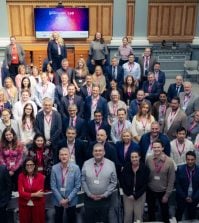From leaders to learners: digital chiefs’ pandemic lessons

Since the pandemic arrived, governments have leaned heavily on technological solutions to protect citizens and businesses. At a GGF webinar, digital leaders from the UK, South Korea and Canada discussed what they’ve learned about delivering and creating online services in a pandemic – and looked for lessons that can be applied in more normal times. Adam Branson reports
It was an enormous task. “We were required in the middle of March 2020 to transition the government to fully remote working in 24 hours,” said Alison Pritchard; nearly 400,000 officials were being abruptly sent home, but at this time of national crisis it was more important than ever that government continued to function effectively.
Nowadays, Pritchard is deputy national statistician at the UK’s Office for National Statistics (ONS); but at the time, she was director general of the Government Digital Service (GDS).

“I would say we probably achieved what might be described as a very minimum viable product,” she recalls. “What we were able to do was break through some of the very first base barriers – so at least being able to do video conferencing collectively across government.” Looking back, she adds, it’s “rather surprising we couldn’t do it at the time. It wasn’t a technical problem; it wasn’t even a security problem. It was an operational problem.”
Some civil services started from a higher baseline, others from a lower one. But all governments confronted by the pandemic had to work fast to digitise existing public services and launch new ones – learning many valuable lessons along the way. To explore civil servants’ experiences of leading digital transformation effectively inside government, in June Global Government Forum convened a webinar – bringing together officials from two UK departments, Canada and South Korea.
According to Pritchard, the UK government’s integrated www.gov.uk platform “really came into its own”, allowing a lot of information and services to be delivered very quickly. “It provided a central point for government engagement with citizens and for citizens to engage with government,” she said. “What would normally take weeks to spin up, we could spin up in days. The COVID-19 landing page is a good example; it was up and running within 24 hours.”

Craig Eblett, digital delivery director at the UK’s Department for Work and Pensions (DWP), noted that his organisation also benefited from their previous investments in digital infrastructure – particularly in supporting online applications for the flagship Universal Credit benefit. However, the department’s 100,000 staff were not at first as well catered for.
Remote possibilities
“Where we were less well equipped was in providing our staff with the ability to work remotely,” he said. “At the start of the pandemic, we had around 5% of our staff who could work successfully remotely. The rest was about face-to-face service provision. But within months we rolled out many tens of thousands of devices, and we now stand at about 95% of the department that can do so. That is just a huge organisational shift that we’ve been through.”
If DWP was starting from a low base when it came to remote working, the team behind the UK’s successful mass vaccination programme was starting from virtually zero – launching a vast new service on the back of the NHS’s notoriously fragmented and idiosyncratic IT infrastructure. According to Scott Adams, UK government lead at webinar knowledge partner Palantir Technologies – a key provider on the programme – this presented both a challenge, and an opportunity: a challenge because getting it right was so clearly essential; and an opportunity because extreme circumstances allow for greater levels of innovation.

“The NHS had to build a completely new supply chain from scratch in six weeks in order to administer tens of millions of doses of a brand-new vaccine. Talk about a salient problem,” he said. “They had to stand up the programme within pretty complex existing systems. To make matters worse, there was a continuous stream of disruptions and uncertainty around basic things like what vaccines were going to be made available, when, and how you were going to be able to store them.”
However, as Adams put it, the NHS “nailed it” remarkably quickly. Among large countries, “they delivered the fastest vaccination rollout in Europe, and one of the key reasons for this is that they led with technology,” he said. “They integrated literally hundreds of data sources into a central source of truth using our software as infrastructure, and they did this in the first six weeks. The result of this work was a data asset with hourly updates.”
Drawing on individuals’ medical records and using the universal NHS number system as a unique identifier, the NHS has delivered a vast vaccination programme – jabbing the most vulnerable first, and responding rapidly as the mix and timing of supplies change – through pharmacies and community buildings as well as healthcare facilities.
Remote physically, proximate virtually
Looking at successful digital initiatives, the panel identified some common factors. For instance, they agreed that for digital services to work well, technologists and data scientists cannot be seen as somehow ‘other’ – operating separately from policymakers, frontline staff and business owners. Instead, they need to work directly with their colleagues from other disciplines, with everyone learning from one another. This was something that Dr Vik Pant, chief scientist and chief science advisor at Natural Resources Canada, said he had learned from the development of his agency’s Digital Accelerator.

“Science informs our economic policymaking, and certainly our economic policy priorities,” he said. “It’s a very good, healthy, mutually symbiotic relationship between our science colleagues and our policy colleagues. We want to make sure that we don’t end up in a situation where you have a group of experts sitting in some corner somewhere and they’re the ones who are the knowledge holders when it comes to the application of these digital technologies.”
That doesn’t mean, Pant continued, that everyone should become experts in everything; but all staff should have sufficient knowledge to understand what is possible. “I like to call it a digital quotient throughout our department,” he said. “It’s not expecting everybody to become a digital expert, but everybody can have access to some learning opportunities where collectively our department can move towards a more data-centric culture.”
Normal rules still apply
Then there is privacy. The panel was at pains to point out that they understood that, even in the worst of times, the benefits that can be derived from greater data sharing have to be offset against citizens’ concerns about highly personal data being shared without their knowledge or against their will. “We have done everything in a way that complies with and abides by all of the governance mechanisms in our department,” said Pant.
“After all, in government we have to make sure that there’s proper oversight, proper compliance and proper monitoring. We just wanted to make sure that everything that we were doing was fully transparent and fully visible to decision-makers at every level of the organisation. Just from the perspective of good governance, we wanted to build credibility and to earn people’s trust and goodwill.”

Seong Ju Park, deputy director in the Digital Government Cooperation Division at South Korea’s Ministry of the Interior and Safety, agreed that data privacy is a concern – particularly when it comes to expanding the use of non-contact services. At the end of last year, she explained, the government rolled out digital IDs for government officials, extending the service this year to cover citizens’ driving licences and disability support services. “Citizens can access services and benefits that they require just on their mobile phone, without having to prove the eligibilities or provide a plastic ID card,” she said, adding that the government’s ‘My Data’ initiative – which puts people in charge of how their data is used and shared – has been integral to take-up.
“Citizens will be now able to review their information held by the government,” said Park. “And then if they choose to do so, they can provide that information to the third party, so a private company. For instance, if they want to get a discount from a mobile carrier, before they had to get a document issued from the government and then send it to the mobile carrier. Now you can just store them in your digital wallet and then send it to the third party.”
Doing the business
The Korean experience also highlighted the importance of working with the private sector if digital services are to be rolled out quickly. Numerous services, Park said, can now be accessed securely through popular local social media platforms, negating the need to download a government-developed app and enabling services to be provided in a “timely manner”.
During the pandemic, linking up with credit card companies in the country allowed relief and stimulus funds to be distributed quickly. “After the peak of COVID-19 in Korea, the government decided to distribute relief funds to all households,” said Park. “It had to be done securely but quickly.”
“If we had taken a traditional approach, we might still be developing the system to distribute the funds,” she said. “However, we were able to distribute the funds to 99% of recipients within a month’s time, thanks to collaborating with 18 credit cards companies here. Our private sector has stepped up really tremendously during the pandemic. With the open data, they launched services to citizens before the government was able to do so. In the future, we’ll continue to work with [the] private sector to make sure that the government and their citizens are prepared for any future crisis to come.”
Finally, the panel was also unanimous on the need to remember that even when digital services are established and working well, not everyone will be able to make use of them. Some people are unable to afford the hardware required; some may lack the necessary skills; a proportion have both problems.
“We do support the most vulnerable in society, and that includes those who are not digitally literate; not digitally aware,” said Eblett. “So we have had a mentee programme and face-to-face services right through the pandemic in order to support citizens in that particular position.”
For Adams, inclusion means considering people’s situations and requirements at a very early stage in a policymaking or service development process, then building civil servants’ plans around those real-world constraints and needs. “We start with a very high-level project plan, but then we go and sit with the user,” he said. “By sitting with a user, you get a really good sense for what they need – and this varies drastically, depending on the profile of the user.”
Those needs will also vary as new challenges arise, requiring civil servants to remain light on their feet in a rapidly-evolving world. But the skills acquired by digital leaders during the pandemic can be applied to every future public policy problem: during the pandemic, civil servants have made huge progress in learning how to apply digital technologies to address the latest crisis – whatever form it takes.





















